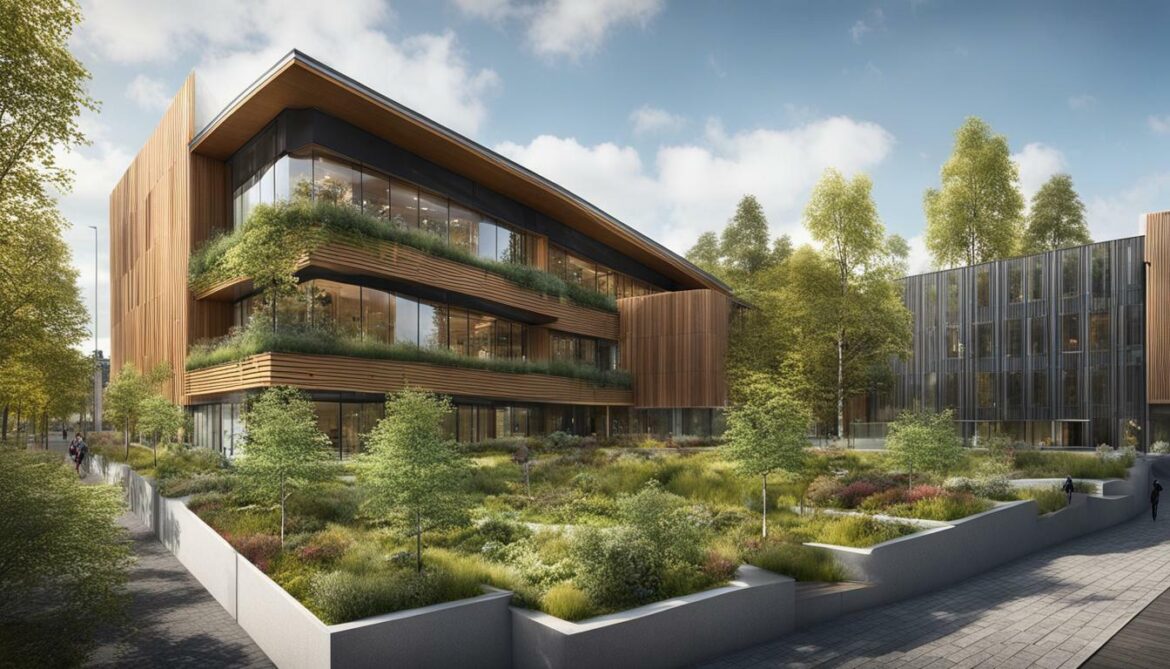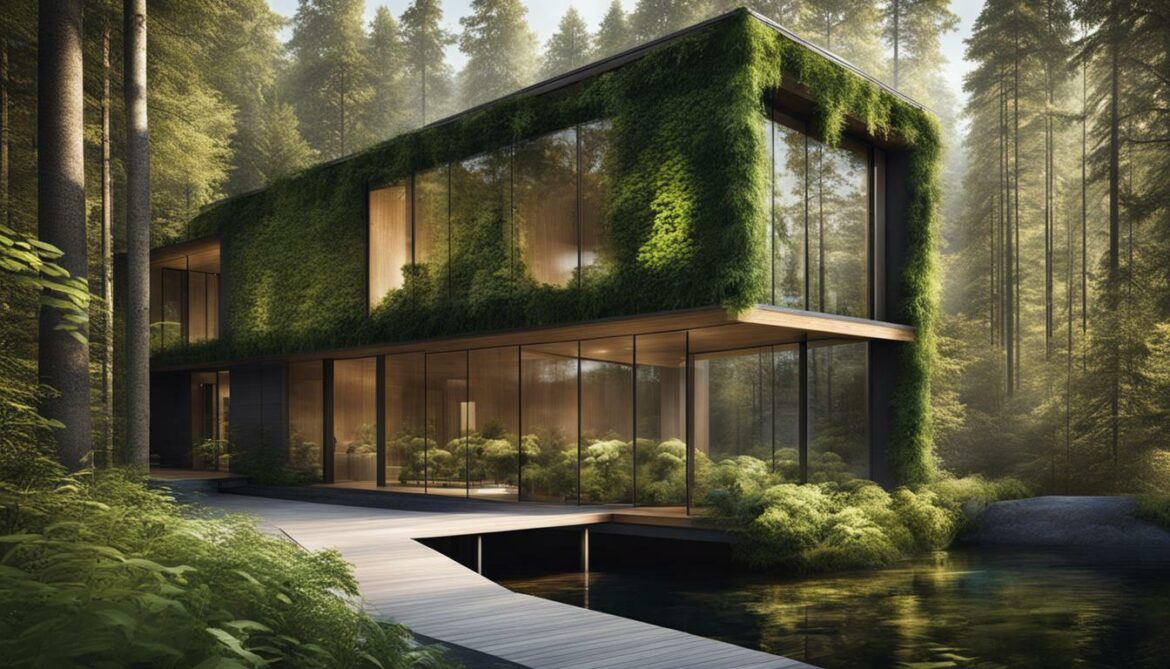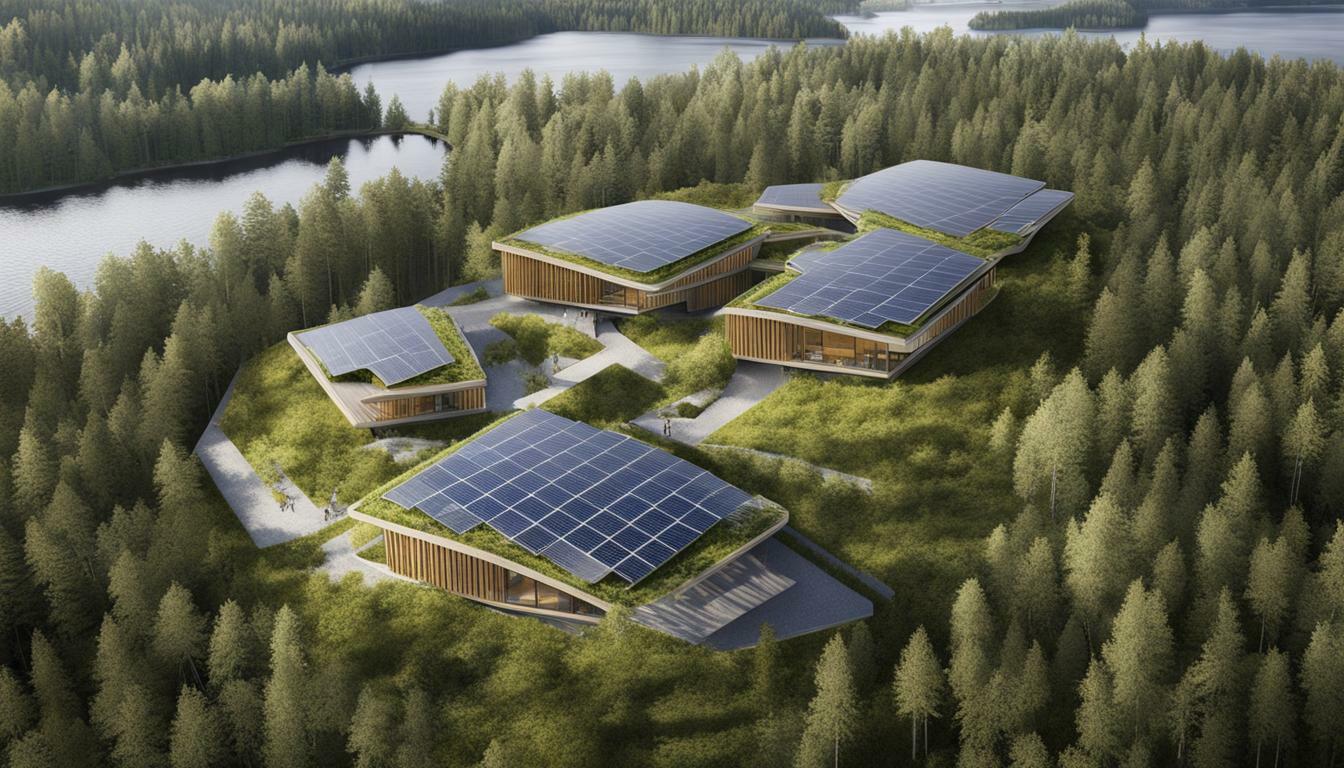Finland is renowned for its top green buildings and sustainable design, where innovative architecture merges seamlessly with an eco-conscious ethos. The country’s commitment to sustainable practices in architecture and construction is evident in its dedication to sustainable architecture, eco-friendly buildings, green building design, environmentally friendly construction, and energy-efficient buildings.
- Finland is known for its green buildings and sustainable practices.
- The Jätkäsaari area in Helsinki is home to “The Greenest of the Green” project.
- Lahti is a role model for sustainability and has transitioned into a modern green city.
- The City of Helsinki’s “Developing blocks of flats” program contributes to sustainable solutions.
- Lahti has implemented energy-efficient homes, renewable energy sources, and a focus on waste management.
The Greenest of the Green Project in Jätkäsaari, Helsinki
In the vibrant Jätkäsaari area of Helsinki, the “The Greenest of the Green” project is revolutionizing green building practices, exploring the benefits of rooftop green spaces on apartment buildings. This innovative project, part of the “Developing blocks of flats” program by the City of Helsinki, aims to create ecologically and socially sustainable solutions for urban living.
The project focuses on the functionality of green areas on the roofs of apartment buildings and their impact on housing and community. It investigates how green facades protect buildings from weather conditions, the growth of plants in challenging conditions, and the adoption of shared green spaces by residents. These findings will contribute to the development of sustainable building practices not only in Helsinki but also in cities across the Nordic and Baltic countries.

The Greenest of the Green Project: Key Highlights
- Exploration of the functionality of rooftop green spaces on apartment buildings
- Evaluation of how green facades protect buildings and enhance energy efficiency
- Investigation of plant growth in challenging conditions and the benefits of shared green spaces
- Contribution to the development of ecologically and socially sustainable solutions
The “The Greenest of the Green” project in Jätkäsaari, Helsinki, is just one example of Finland’s commitment to sustainable and green practices in construction and architecture. The country’s dedication to environmentally friendly construction materials and innovative building techniques has positioned it as a global leader in sustainable development.
Finland’s top green buildings and sustainable practices not only showcase the country’s environmental stewardship, but also serve as inspiration for other nations seeking to create a more sustainable future. With its focus on eco-conscious architecture and energy-efficient design, Finland continues to lead the way in sustainable building practices.
Lahti – Transitioning to a Sustainable City
Lahti, a city that has emerged as a beacon of sustainable living, has embraced eco-conscious architecture and implemented various green building practices, establishing itself as a role model for other cities. As the European Green Capital, Lahti’s commitment to sustainability is evident in its innovative initiatives and environmentally friendly infrastructure.
The city’s transformation from an industrial town to a modern green city is remarkable. Lahti has prioritized energy-efficient homes, relying on renewable energy sources to power its communities. With a strong focus on waste management and recycling, Lahti has cut its overall emissions and eliminated coal as an energy source.
One of Lahti’s notable achievements is its commitment to achieving a zero waste circular economy by 2050. This ambitious goal has paved the way for innovative waste management systems and a shift towards sustainable consumption and production practices. Lahti’s efforts in waste reduction and recycling have positioned the city at the forefront of circular economy development.
The Personal Carbon Trading Model
Lahti has also introduced a unique personal carbon trading model, which gives residents a carbon budget to regulate their emissions. This innovative approach encourages individuals to actively monitor and reduce their carbon footprint, fostering a sense of responsibility and accountability towards the environment.
Furthermore, sustainability extends beyond the city’s infrastructure to its arts, culture, and sports sectors. Lahti takes pride in its carbon neutral orchestra, highlighting its commitment to offsetting carbon emissions associated with cultural events. Even the local hockey club is striving to become carbon neutral, demonstrating how sustainability can be integrated into various aspects of community life.

In conclusion, Lahti’s transition to a sustainable city exemplifies Finland’s commitment to eco-conscious architecture, sustainable building materials, and green construction practices. By embracing renewable energy sources, implementing effective waste management systems, and involving the community in sustainable initiatives, Lahti has set an example for other cities to follow. The city serves as a testament to the positive impact of sustainable development and the potential for a greener future.
Finland’s Environmental Stewardship
Finland’s top green buildings and sustainable practices exemplify the nation’s unwavering commitment to environmental stewardship, utilizing innovative architecture and environmentally friendly construction methods. One notable example can be found in the Jätkäsaari area of Helsinki, where the “The Greenest of the Green” project is currently underway. This project aims to explore the functionality of green areas on the roofs of apartment buildings and their impact on housing and community. By studying how green facades protect buildings from weather conditions and the growth of plants in challenging environments, the project seeks to design ecologically and socially sustainable solutions. The results of this project will be invaluable for cities in the Nordic and Baltic countries, as it contributes to the ongoing efforts to create greener and more sustainable urban spaces.
In addition to Jätkäsaari, the city of Lahti has emerged as a role model for sustainability in Finland. Once an industrial town, Lahti has undergone a remarkable transformation into a modern green city and has been recognized as the European Green Capital. The city’s commitment to sustainability is evident in various aspects of its urban planning and development. Energy-efficient homes, reliance on renewable energy sources, and a strong focus on waste management and recycling are just some of the sustainable practices implemented in Lahti. Notably, the city has successfully reduced its overall emissions and eliminated coal from its energy production. With a goal of achieving a zero waste circular economy by 2050, Lahti has prioritized sustainability as a core principle of its future development.
Lahti’s environmental expertise extends beyond traditional areas of sustainability. The city has introduced a personal carbon trading model, wherein residents are given a carbon budget to regulate their emissions. This innovative approach encourages individuals to actively participate in reducing their carbon footprint and contributes to the overall sustainability goals of the city. Furthermore, sustainability initiatives have permeated into the arts, culture, and sports sectors in Lahti. From a carbon neutral orchestra to a hockey club striving to become carbon neutral, the city has embraced sustainability in all aspects of its community life.
Finland’s Commitment to Green Building and Construction
Finland’s focus on sustainable architecture and environmentally friendly construction extends beyond individual projects and cities. The country as a whole has prioritized green building practices as an integral part of its national goals for sustainability. From stringent regulations to certification systems, Finland has implemented measures to promote sustainable practices throughout the construction industry. The use of eco-friendly materials, energy-efficient design, and the reduction of carbon emissions have become paramount in building projects across the country. These efforts have positioned Finland as a global leader in sustainable architecture and environmentally conscious construction.
| Key Features of Finland’s Environmental Stewardship |
| Commitment to green building practices |
| Utilization of eco-friendly materials |
| Promotion of energy-efficient design |
| Reduction of carbon emissions |
In conclusion, Finland’s top green buildings and sustainable practices are a testament to the nation’s enduring dedication to environmental stewardship. Through innovative architecture, environmentally friendly construction methods, and a holistic approach to sustainability, Finland is leading the way towards a greener and more sustainable future.

Finland’s top green buildings and sustainable practices have positioned the country as a global leader in environmentally conscious construction, with innovative designs and a commitment to sustainable building materials and energy efficiency. One notable example is the “The Greenest of the Green” project in the Jätkäsaari area of Helsinki, which explores the functionality of green areas on the roofs of apartment buildings.
The project aims to understand how green facades can protect buildings from weather conditions, promote plant growth in challenging environments, and encourage the adoption of shared green spaces by residents. The findings from this project will contribute to the development of ecologically and socially sustainable solutions, not only in Finland but also in other cities in the Nordic and Baltic countries.
Meanwhile, Lahti, a city in Finland, has become a role model for sustainability. As the European Green Capital, Lahti has successfully transitioned from an industrial town to a modern green city. The city has implemented various sustainable practices, including energy-efficient homes, reliance on renewable energy sources, and a strong focus on waste management and recycling.
Lahti’s commitment to environmental stewardship can be seen in its goal of achieving a zero waste circular economy by 2050 and its successful elimination of coal. The city has also introduced a personal carbon trading model, where residents are given a carbon budget to regulate their emissions. Sustainability has extended beyond infrastructure to the arts, culture, and sports sectors, with initiatives such as a carbon neutral orchestra and a hockey club striving to become carbon neutral.
Finland’s dedication to sustainable architecture, eco-friendly construction, and energy-efficient design showcases its commitment to creating a more sustainable future. The country’s top green buildings and sustainable practices not only contribute to reducing its carbon footprint but also inspire other nations to follow suit in the global movement towards a more environmentally friendly built environment.
FAQ
What is the “The Greenest of the Green” project in Jätkäsaari, Helsinki?
The “The Greenest of the Green” project is an initiative taking place in the Jätkäsaari area of Helsinki. Its aim is to explore the functionality of green areas on the roofs of apartment buildings and their impact on housing and community.
What aspects does the “The Greenest of the Green” project investigate?
The project investigates how green facades protect buildings from weather conditions, the growth of plants in challenging conditions, and the adoption of shared green spaces by residents.
What is the goal of the “The Greenest of the Green” project?
The project aims to collect information that will help design ecologically and socially sustainable solutions. The results can be applied in cities in the Nordic and Baltic countries.
How has Lahti become a role model for sustainability?
Lahti, a city in Finland, has transitioned from an industrial town to a modern green city. It has implemented various sustainable practices, including energy-efficient homes, reliance on renewable energy sources, and a strong focus on waste management and recycling.
What is Lahti’s target for achieving a zero waste circular economy?
Lahti aims to achieve a zero waste circular economy by 2050. The city has already made significant progress in cutting its overall emissions and eliminating coal.
What is Lahti’s personal carbon trading model?
Lahti has implemented a personal carbon trading model where residents are given a carbon budget to regulate their emissions. This model promotes individual accountability and encourages sustainable behavior.
How has Lahti embraced sustainability in the arts, culture, and sports sectors?
Lahti has extended its commitment to sustainability beyond construction and energy by implementing initiatives such as a carbon-neutral orchestra and a hockey club striving to become carbon neutral. These efforts demonstrate the city’s holistic approach to sustainability.
What do Finland’s top green buildings and sustainable practices demonstrate?
Finland’s top green buildings and sustainable practices demonstrate the country’s commitment to environmental stewardship and the development of ecologically and socially sustainable solutions. They showcase Finland’s dedication to minimizing its carbon footprint and promoting sustainable architecture and construction.
Source Links





















Post comments (0)